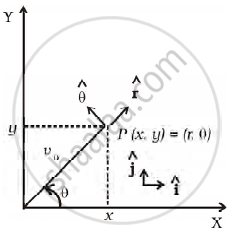Advertisements
Advertisements
प्रश्न
For any arbitrary motion in space, state whether the following statement is true:
`"r"("t") = "r"(0) + "v"(0)"t" + 1/2 "a" "t"^2 `
(The ‘average’ stands for average of the quantity over the time interval t1 to t2)
पर्याय
True
False
उत्तर
This statement is False.
Explanation:
The particle's motion is arbitrary; the acceleration of the particle may also be non-uniform. Hence, this equation cannot represent the motion of a particle in space.
APPEARS IN
संबंधित प्रश्न
In a harbour, wind is blowing at the speed of 72 km/h and the flag on the mast of a boat anchored in the harbour flutters along the N-E direction. If the boat starts moving at a speed of 51 km/h to the north, what is the direction of the flag on the mast of the boat?
For any arbitrary motion in space, state whether the following statement is true:
`"V"_"average"` = `(1/2)("v"("t"_1) + "v"("t"_2))`
(The ‘average’ stands for average of the quantity over the time interval t1 to t2)
For any arbitrary motion in space, state whether the following statement is true:
`"V"_"average"` = [r(t2) - r(t1) ] /(t2 – t1)
For any arbitrary motion in space, state whether the following statement is true:
v (t) = v (0) + a t
(The ‘average’ stands for average of the quantity over the time interval t1 to t2)
In a two dimensional motion, instantaneous speed v0 is a positive constant. Then which of the following are necessarily true?
In a two dimensional motion, instantaneous speed v0 is a positive constant. Then which of the following are necessarily true?
Motion in two dimensions, in a plane can be studied by expressing position, velocity and acceleration as vectors in cartesian co-ordinates A = `A_xhati + A_yhatj` where `hati` and `hatj` are unit vector along x and y directions, respectively and Ax and Ay are corresponding components of (Figure). Motion can also be studied by expressing vectors in circular polar co-ordinates as A = `A_rhatr + A_θhatθ` where `hatr = r/r = cos θhati + sin θj` and `hatθ = - sin θhati + cos θ hatj` are unit vectors along direction in which `r` and `θ` are increasing.

- Express `hati` and `hatj` in terms of `hatr` and `hatθ`
- Show that both `hatr` and `hatθ` are unit vectors and are perpendicular to each other.
- Show that `d/(dt) (hatr) = ωhatθ` where `θ = (dθ)/(dt)` and `d/(dt) (hatθ) = - ωhatr`
- For a particle moving along a spiral given by `t = aθhatr`, where a = 1 (unit), find dimensions of ‘a’.
- Find velocity and acceleration in polar vector representation for particle moving along spiral described in (d) above.
A small toy starts moving from the position of rest under constant acceleration. If it travels a distance of 10 minutes, the distance travelled by the toy in the next will be ______.
Boat travels upstream in a river and at t = 0 a wooden cork is thrown over the side with zero initial velocity. After 7.5 minutes the boat turns and starts moving downstream catches the cork when it has drifted 1 km downstream. Then the velocity of water current is ______.
The displacement s of a particle depends on time t according to the following relation `s = 1/3t^3 - t^2 + t`. The velocity and displacement of the particle at the instant when its acceleration is zero, are respectively ______.
